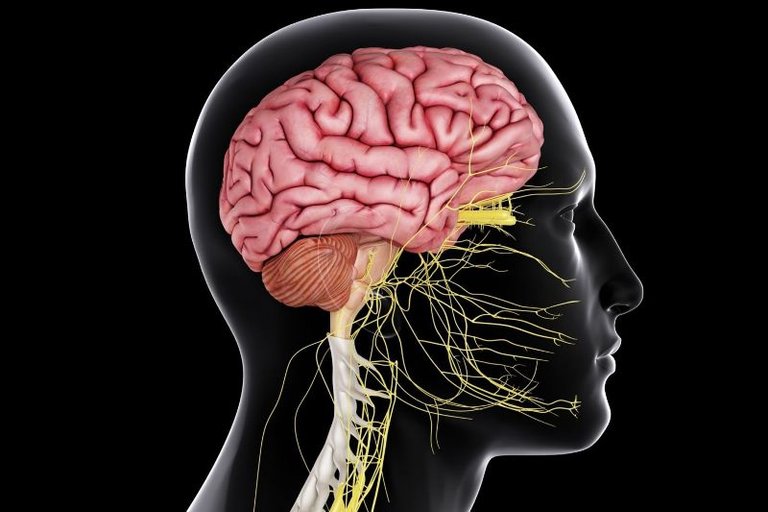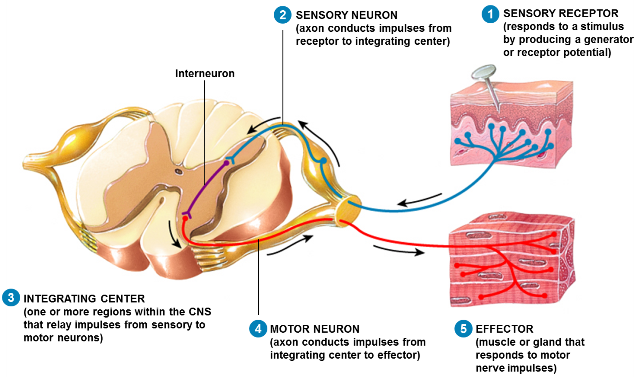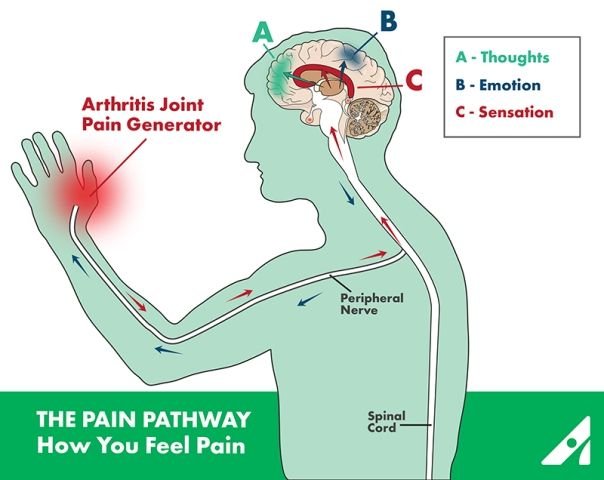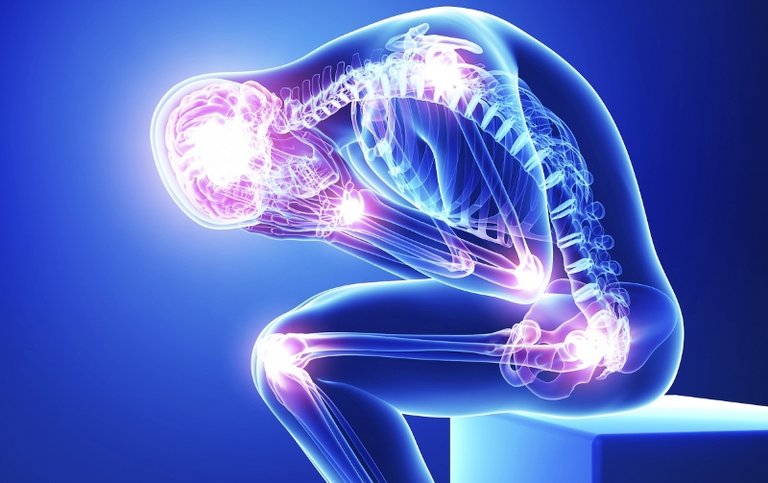Hello my steemian friends!
Welcome to our new post in the science series!
What sensation you feel when you get a cut from a knife? or when you fall from a bicycle? Or when you have a stomach problem or any other disease??
From simplest of the accidents to the deadliest of the diseases, the first thing that gets our main concern , that hampers our daily activity and function is 'Pain'.
"But, have you ever Wondered why do we feel so? Where does the pain come from? Is there any purpose of having pain? What might happen to us when we start feeling no pain??Why the nature has made like this??"
What is Pain & Where does it come from ??
Pain is an unpleasant sensory and emotional experience due to tissue damage or impending tissue damage. It's an basic act of our nervous system.In order to know how it occurs you should first know about how our nervous system works. our nervous system is very complicated but i will try to make it as simple as possible.
Human Nervous System

Fig. Human Nervous system - credits
Human Nervous system consists of-
- Central nervous nervous system- Brain and spinal Cord
- Peripheral nervous system - Nerve fibres arising from brain and spinal cord, These are further divided into sensory and motor nerve fibres.
The basic nervous circuit consists of-
- Receptor
- Sensory nerve
- Central Integration centre
- Motor Nerve
- Effector organ

Fig. The basic neuronal circuit- credits
The steps in a basic neuronal circuit--
1.--The sensory receptors are located in various parts of body, these are skin, retina of eye, cochlea of ear, olfactory cells of nose and taste buds of tongue. These receptors are also located in the covering of internal organs like our Gut, liver lung, heart etc.
2.--When an stimulus is given to these receptor for example- pinprick in skin or a whisper in the ear or a picture in front of eye, the sensory nerves get stimulated. these nerve carry the information about stimulus and reach central nervous system i.e. spinal cord and brain.
3--The integration of the information received from sensory nerves takes place in the central nervous system. The information passes to respective area of brain, for example - the information of light passes to occipital lobe of brain, touch goes to somatosensory area and that of smell goes to olfactory area. and the brain responds in three forms- 1. thought, 2. emotion 3. action
4 & 5--The respone of brain for the stimulus is carried by motor nerve to the effector organs, the effector organ may be any organ that is linked to the stimulus. for example- When a person shows you a picture, the information is by retina of eye to the brain, the info is integrated in brain , brain decides what to do with it and you respond by smiling or by speaking , in this case the effector organ is muscle of facial expression and the muscle of tongue
So Upto now you know a neuronal circuit works, now we will use this knowledge to discuss about "where does the pain come from"!

Fig.- The Pain Pathway
The pain pathway is not much different from the the neuronal circuit we discussed above. we will try to describe in the similar way--
When there is any tissue damage various chemical messangers are released from the tissues. for example- When a person pricks his finger with a pin, it damages the skin tissues. The chemicals released from the cells in turn stimulate the sensory nerves terminals, which are known as pain receptor or Nocciceptors. Sensory nerves pass that information to the central nervous system and integration of that information occurs in various parts of Brain as shown in the figure above.
Sstimulation of Somatosensory cortex- localizes the site of injury.
Stimulation of Insular cortex and Cingulate gyrus- various emotions that a person develps in pain are because of stimulation of this cingulate gyrus and the perception of pain is due to stimulation of insular cortex.
Various Brain Studies([Link Here]) using Co2 laser stimulation and Imaging techniques have shown that central stimulation of Insula and cingulate cortex can generate Perception of pain without peripheral stimulation!
This was all about the Science Behind the pain.
What is the purpose of pain??
Pain is a natural protective mechanism.It is an indicator that tells something is not right , something wrong is happening to the body.
.
It triggers the avoidance mechanism- i.e.When you put your finger on the fire you will perceive pain and due to the reflex action you will rapidly draw your hand out from the fire, it is the short term avoidance.It also triggers long term avoidance- i.e. you will never put your finger again in the fire in the future if you had done once in the past, thus it helps in decreasing the extent of injury By avoiding the noxious stimulus.
.
When one is in pain, The physical activity decreases,the injured part remains immobile till the pain fades away.and because of the immobility faster healing occurs. Thus, pain is also a factor for rapid recovery from injury or a disease process.
.
Pain is like a Warning sign for many diseases, for example -Before the attack of myocardial infarction( commonly known as heart attack), there will be intense chest pain radiating to left shoulder, if not treated within 1 hour of onset of pain the person will develop Heart attack and death is very likely. Thus,By identifying the nature of this pain we can prevent the Disease process. It is just one example and there are many.
"But pain is not always a good thing.The Concept of Acute and Chronic pain!"
Acute pain is a sudden onset pain that occurs immediately after the disease process or a tissue injury. It lasts for short period of time and disappears spontaneously or after the treatment. Examples are- Fractures, Road Traffic Accidents, Surgical procedures etc..
Chronic pain is a type of pain that persists even after the treatment or after the disease has healed. There is only symptomatic treatment ,it cannot be cured. It decreases the quality of life and social function. Chronic pain not only hampers the organ involved but also can whole body. Chronic pain increases the pain sensitivity and person will feel pain even after the simple touch, this is known as Hyperalgasia. The examples are- Migraine, Arthritis, Malignancy, Neuropathies.
So, Only the acute pain is a good for human health.
What might happen to us if we do not perceive the Pain??
There are some diseases where a person can not perceive the pain or has decreased pain sensation. As we have already discussed the protective functions of pain, these people will not feel pain even in severe tissue damage, so there will be high chance that they will suffer from severe diseases . These conditions are-
- Congenital insensitivity to pain (CIP)- it is a rare disease where a person can not feel pain sensation right from the birth.But can feel other sensations like touch, pressure, temperature .
- Diabetes Mellitus- In case of diabetic neuropathy some of peripheral nerves are damaged. Mostly the nerves of foot are involved, person can not feel pain when there are simple injuries on the foot. these injuries grow and eventually become large ulcer and in some instances amputation of leg is the only treatment.
- Other peripheral Neuropathies
Conclusion:
Pain is an unpleasant sensory and emotional experience due to some tissue damage or impending tissue damage. Tissue damage excites pain receptors(Nocciceptors).From the pain receptors the sensory nerves carry information to the central nervous system and in turn stimulate various pain centres in the brain. Stimulation of insular cortex in the brain is found to be the main cause of pain perception. various studies have shown the perception of pain in a person after artificial stimulation of that area.Pain, usually the acute pain is the natural protective mechanism of the body, it signifies the extent of tissue damage and it disappears when the injury heals. But chronic pain is opposite to that, it persists even after the healing of disease process, it can not be cured & it decreases the quality of life and social function of a person.
so the main theme of this topic is - "Pain is natural protective mechanism of the body which helps in identifying the pathology , limiting the injury and acclerating the recovery.
Credits- [1], [2], [3], [4],[5]
- Upvote
- Resteem
- Follow @himal

Very nice post ;)
thank you very much @sava !
A friend of mine once told me that pain is a resultant effect of impulse clash. I don't know if he's right of wrong but I'm yet to prove it.
Nice post there. Upvoted
thanks @samminator . yeah kind of impulse..a nerve impulse
Congratulations! This post has been upvoted from the communal account, @minnowsupport, by doc.himal from the Minnow Support Project. It's a witness project run by aggroed, ausbitbank, teamsteem, theprophet0, and someguy123. The goal is to help Steemit grow by supporting Minnows and creating a social network. Please find us in the Peace, Abundance, and Liberty Network (PALnet) Discord Channel. It's a completely public and open space to all members of the Steemit community who voluntarily choose to be there.
If you like what we're doing please upvote this comment so we can continue to build the community account that's supporting all members.